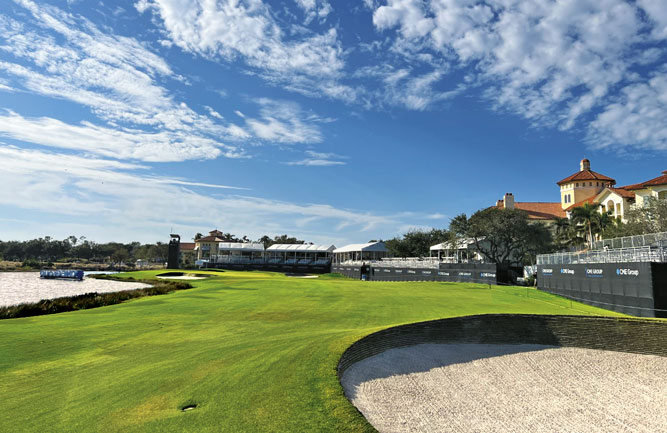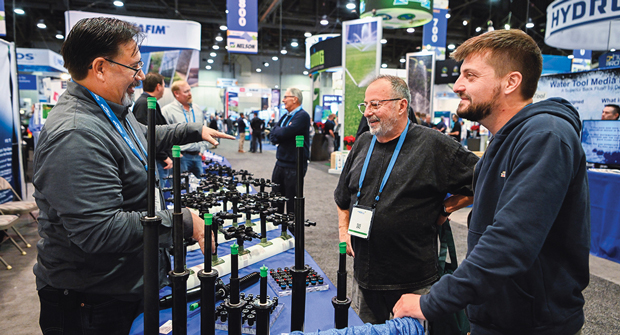Experts’ Insights: Anthracnose

A symptom of anthracnose includes basal rot where crowns are necrotic and dark infection mats are visible on lower leaf sheaths. (Photo: John Kaminski)
Anthracnose is not a new problem on golf courses. In fact, a team of researchers from around the country and Canada have worked for more than 20 years to dispel anthracnose myths and promote best management practices. This research team includes experts from Rutgers University, including Bruce Clarke, Ph.D., an Extension specialist in turfgrass pathology, and James Murphy, Ph.D., an extension specialist in turf management, as well as graduate students.
While it’s readily known that anthracnose strikes annual bluegrass and bentgrass, the research team set out to discover how management practices could influence the severity of this disease. One myth to dispel concerned the role that topdressing has on the disease, which was believed to be wound induced.
Because sand topdressing is abrasive, it was thought to be a practice best avoided. The data show the contrary — topdressing creates a firm surface that can effectively allow raising the height of cut.
“Sand topdressing is a very good agronomic practice. Because the plants stand up straight when they’re supported by sand, they’re more photosynthetically active, they’re harvesting the sunlight more effectively and the crowns are protected from heat,” Clarke says. “Everybody knew it was a good agronomic practice, but they were afraid of wounding turf.”
However, stress is a major cause of anthracnose. One best management practice the research team identified — which you can find it here — encourages superintendents to raise mowing heights to reduce the amount of stress (heat stress, drought stress, you name it) to which the turf is exposed.
“The reason superintendents lower mowing height is to maintain turf quality and performance, and performance on golf courses is essentially green speed,” Clarke says. “Anthracnose is a poster child for how good agronomic practices can reduce disease. If you maintain the turf well and it’s healthy and it’s happy, it’s less susceptible to anthracnose. If you weaken it by lowering mowing height, nitrogen fertility and soil moisture — trying to increase green speed at the sake of turf health — then you’re going to enhance the potential for this disease.”
Experts suggest double cutting and rolling greens to help maintain acceptable turf quality expected by golfers while reducing disease and thus the chemicals needed to treat it.
“We’ve come up with a set of best management practices that have really helped people understand the disease and reduce its severity while actually reducing the fungicide usage,” Clarke says.

Ian Rodriguez
Quali-Pro
Ian Rodriguez
Technical services manager, Control Solutions Inc.
Anthracnose is most problematic on closely mown annual bluegrass and creeping bentgrass turf during summer months when it’s hot and humid. Symptoms include yellowing leaves with small, black fruiting structures. It’s also commonly associated with poor nitrogen fertility. A good preventive fertility approach is to spoon-feed soluble N and maintain good potassium levels. Begin preventive fungicide programs several weeks before favorable conditions are expected. Combining multiple modes of action has shown to be more effective than single fungicides, and rotation is key in an extended control program.

Rick Fletcher
Nufarm
Rick Fletcher
Technical services manager, turf and ornamentals
There are two types of anthracnose symptoms, basal rot and foliar blight, that occur from May to September in most cool-season turf. With foliar blight, older leaves are attacked first, with reddish-brown to brown lesions that turn pale tan. For basal rot, dark infection mats are visible on lower leaf sheaths, and diseased crowns are necrotic. Leaves are yellow-orange. In both cases, the fungus can produce fruiting structures that have fine, black, hairlike projections and that are filled with small, crescent-shaped spores. Review current agronomic practices and modify N levels and other nutritional supplements (like kelp extracts), height of cut, watering and plant growth regulator use to reduce stress. Fungicides — in addition to improved agronomics — provide the best path for prevention, management and recovery.

Mike Agnew
Syngenta
Mike Agnew
Technical services manager
There is a direct relationship between heat, drought stress and anthracnose. It’s recommended to avoid drought stress and syringe and/or hand water on an as-needed basis. Cultural practices also help prevent the disease. Increase mowing height slightly and use solid rollers in the summer. Light, frequent sand topdressing can cushion the stem base. You also can apply small amounts of nitrogen (0.1 lb. to 0.15 lb./1,000 sq. ft.) every 14 days. Using a plant growth regulator helps reduce disease activity by improving plant growth. Increasing mowing height and adding nitrogen also can help encourage plant recovery if anthracnose already is present. Preventive applications of appropriate systemic fungicides can be highly effective for preventing anthracnose.

Brian Aynardi
PBI-Gordon Corp.
Brian Aynardi, Ph.D.
Northeast research scientist
Anthracnose is a common disease of annual bluegrass and creeping bentgrass maintained at low heights of cut under stressful conditions. The disease is caused by the ascomycete fungus Colletotrichum cereale. It’s diagnosed by the presence of black fruiting structures called acervuli and lunar-shaped condia. Older leaves of infected tissue are yellow or orange. The disease manifests itself as foliar blight or basal rot. Manage anthracnose by reducing plant stress through cultural practices, including raising mowing heights, topdressing regularly, increasing drainage, providing adequate potassium and phosphorous levels and putting down biweekly applications of quick-release nitrogen at a rate of 0.1 lb. to 0.2 lb. N/M. Demethylation inhibitor, succinate dehydrogenase inhibitor, nitrile and strobilurin fungicides are effective in controlling the pathogen.











